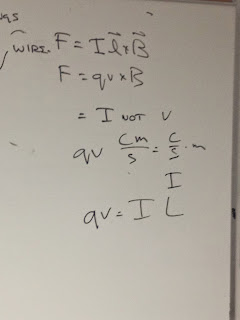Today we go over more about magnetic fields, this time focusing more about magnetic motors
 |
| Morning exercisee |
The first portion of the lab was a recap on how magnetic field and magnetic force works. We were given an area with a magnetic field pointing a certain direction, and was asked to find where the force was at a certain point.
We find that since the magnetic field is perpendicular to its force, that only the top and bottom portions of the area would exert any force at all
Alongside the morning exercise, we learned that when the magnetic force is parallel to an object, that it exerts no torque, meaning that the center at which the object rotates does
 |
| Relating force to torque |
We then took what information we know about magnetic force and Torque and applied them into an equation that could now find torque, using the magnetic field, the area, and the current of the system
 |
| Explanation of a magnetic motor |
The next picture showed an interesting lab, in which Prof Mason shows to us that it is possible to rotate the magnet in the middle using nothing but magnetism. By constantly having the switch move between positive and negative at a specific point (once the magnet was given an initial push), we showed that it was possible to get the magnetic to rotate both clockwise and counterclockwise.
It is to note however, that the way this motor was created was fairly inefficient as it took near perfect precise timing in order to get the magnetic to spin at a relatively fast rate.
 |
| More explanation of a n electric motor |
Prof Mason goes on to explain that when the electric motor operates, when it reaches to a certain "grey" area, it actually temporarily turns off, before it goes back, which was seen during the electric motor demonstration
 |
| A Saint Louis Motor |
Our next lab required working alongside the Saint Louis Motor, a motor that has two magnets on the opposite side of each other and some metal in the middle of it. It spins once we added current to the system. We were then asked to answer a few questions (on the next picture below) on the Saint Louis motor, and if any changes occur when we switch it from its initial set up.
It is to note our specific motor took some time to spin, as it requires very little friction to operate smoothly
 |
| Our answers to the Saint Louis Motor Lab |
 |
| Creating our electric motor |
Our next task, once we took an understanding of how a motor works was to create a simple electric motor ourselves, using some current, powerful magnets, and some coiled wire (making sure we sand 180 degrees to remove the copper)
It is to note that the setup that we have in our picture was not our original setup, but the initial setup was much more complicated and took more time than needed for it to work .
 |
| A video of the simple motor operating |
 |
| Setup of the Magnetic Field near a current-carrying wire |
In this next lab, The Magnetic field near a current carrying wire, we studied what would occur to a bunch of compass needles if it was placed circular to a rod that is carrying current, and thereby a magnetic field.
Our initial prediction was that all of the metals would all point at the metal rod, for that is the one providing the current
 |
| Magnetic Field near a current-carrying wire experimentation |
We find out that the compass needles are not pointing to the current-carrying rod, but rather it follows the magnetic field that the current is producing, which turns out to be counterclockwise
 |
| Our theory and actuality in this lab |
 |
| Setup of the experimentation |
The last lab talks about whether or not a magnetic field can superimpose each other, or does the magnetic fields change due to different wiring arrangement. We were asked to predict the strength of the magnetic field at three points, one initially at the beginning, once it goes down the first hill, and after it goes through a loop

Although not all were being shown, we do find out that the magnetic field does in fact change throughout the system. I believe it was the loop itself that showed to have no magnetic field, due to the fact that the magnetic fields of both the top and the bottom are cancelling each other out, creating no magnetic field as a result.
We ended class by understanding just how important the relationship between electricity and magnetism is (and how electromagnetic force came to be) by looking at their equations, and from that coming up with a ratio between the two forces






















































